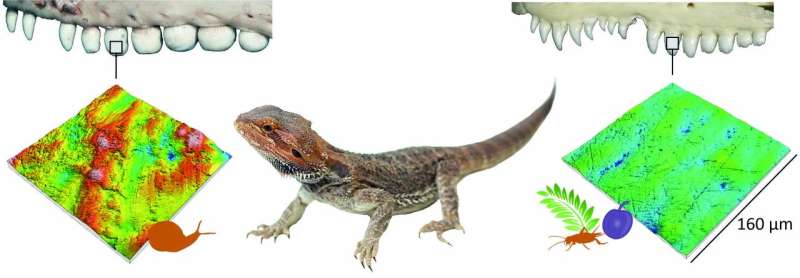Dental microwear provides clues to dietary habits of lepidosauria

High-resolution microscopic images of the surface of dental enamel of lepidosauria, which is a subclass of reptile including monitor lizards, iguanas, lizards and tuatara, allow scientists to determine their dietary habits. The enamel wear patterns reveal significant differences between carnivores and herbivores, but also allow finer distinctions, such as between algae-, fruit-, and mollusk-eating species. These findings are the result of research by a team led by scientists at Johannes Gutenberg University Mainz (JGU). They point out that it has hitherto been difficult to make such fine distinctions between dietary behavior on the basis of dental or skeletal remains alone, particularly in the case of extinct species, because in many reptiles the teeth are of similar shape.
As the researchers report in Proceedings of the Royal Society B, they examined the upper teeth of 77 curated reptile specimens found in the wild and belonging to 23 extant species; the specimens were part of the collections of various natural history museums. For some of the samples, the researchers analyzed pieces of jaw containing teeth directly under a confocal microscope, while in other cases they made silicone impressions of the teeth which they then imaged. They created 3-D surface models of the teeth and evaluated them with regard to 46 characteristics, such as the number of furrows in the enamel and their mean depth.
As a result, they determined that the animals could be grouped into different dietary categories based on their dental microwear textures. For example, the tooth enamel of carnivores exhibits only a few shallow furrows, whereas the enamel of frugivores is very deeply furrowed. "This method was developed based on mammals. We applied it for the first time to reptiles and were able to show that it also works for lepidosauria," said Dr. Daniela Winkler of the Institute of Geosciences at JGU, lead author of the research paper. This was not necessarily what they had expected: "Reptiles hardly ever chew their food. Most of the time they simply bite off pieces of food and swallow them whole. Thus there was no guarantee that we would find informative traces of wear."
The researchers now hope to be able to use the method to analyze teeth from dinosaurs and synapsids, which are very similar to those of lepidosauria, as well and finally identify the first herbivores among the terrestrial vertebrates. Synapsids are mammal-like reptiles, which inhabited the Earth around 310 million years ago, pre-dating dinosaurs by 70 million years. Some of them evolved from carnivores into herbivores. "This was a key event in evolution," emphasized Winkler. "Our long-term goal is to find out when exactly this happened and in which species."
More information: Daniela E. Winkler et al. Dental microwear texture reflects dietary tendencies in extant Lepidosauria despite their limited use of oral food processing, Proceedings of the Royal Society B: Biological Sciences (2019). DOI: 10.1098/rspb.2019.0544
Journal information: Proceedings of the Royal Society B
Provided by Universitaet Mainz





















